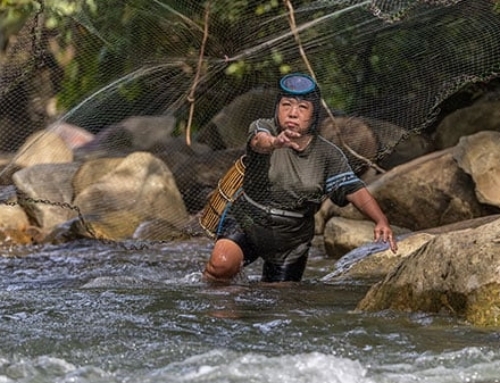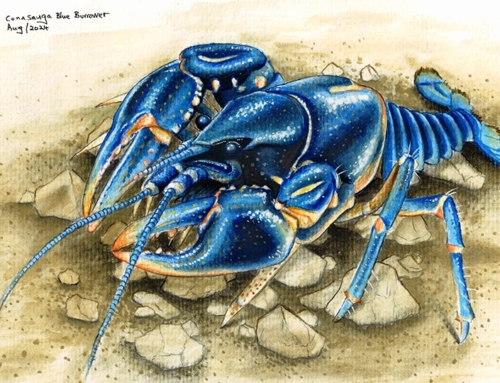Jeremy Wade is a TV presenter, angler and author, best known for the series River Monsters and, more recently, Mighty Rivers. With a background as a biologist, Jeremy has visited many of the world’s most iconic rivers and lakes, seen and fished for some of their most extraordinary species and witnessed the changes happening to the planet’s greatest freshwater ecosystems.
Jeremy shared some stories and thoughts at the recent launch of Shoal, a new initiative for freshwater conservation hosted by Synchronicity Earth. I spoke to him afterwards about some of the challenges for freshwater conservation and how he thinks Shoal can contribute.
Q: Was there a moment you realised that a lot of rivers you were spending time on were in trouble, or was it more of a gradual realisation?
JW: A bit of both, really. It has been gradual, but there have also been moments where it’s really hit home.
Right from the start, I was aware that for the kind of fish I was looking for, it wasn’t just that people weren’t going and fishing for them, it was actually that these fish were disappearing because of all the damage that has been done to rivers in recent years.
One experience that really brought it home was the last time I went to the Congo. I was in a place on the Congo River where very few outsiders go, somewhere with a very low population density. I went to one village where people have a history of fishing for catfish and the scarcity of these fish – we’re talking about the main Congo here – really struck me. It is shocking to see the impact that even a small human population can have on fish.
Q: Why do you think that freshwater is something of a ‘cinderella issue’, and doesn’t get the attention that, for example, tropical forests or coral reefs get?
JW: I think it boils down to two things. Firstly, you can’t see the animals you’re talking about – or at least most people can’t – so it’s a lack of visibility. And then, if you do get to see them, a lot of freshwater fish are not great looking!
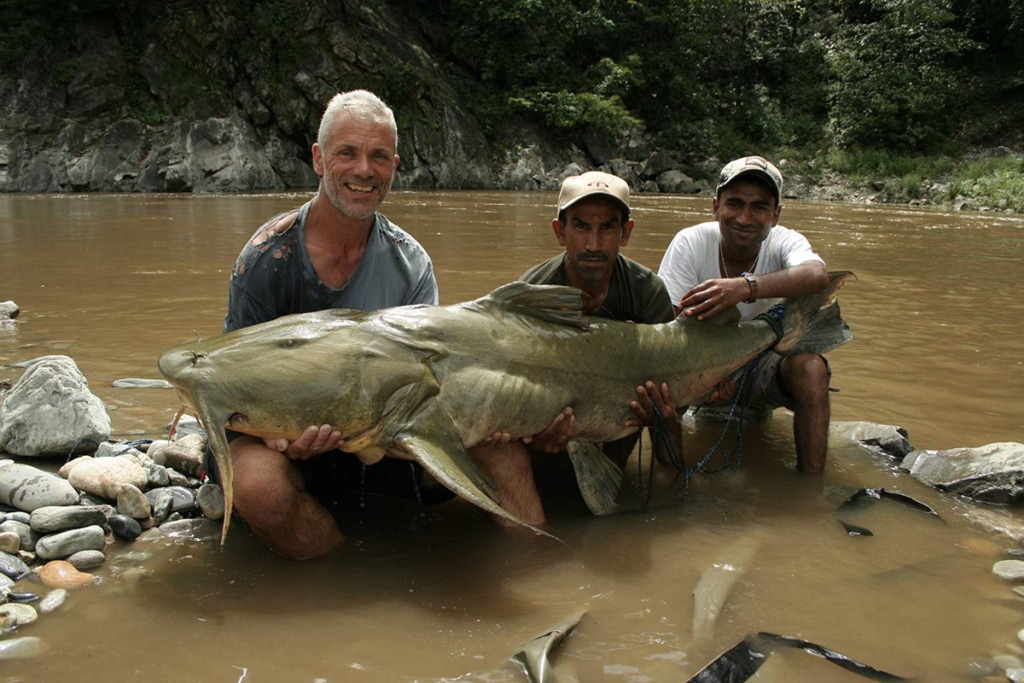
Goonch catfish (Bagarius Yarrelli ) © Icon Films
I used to do quite a bit of diving and I always wanted to be diving in rivers, where you’re generally not going to see very far. Most divers are interested in coral reefs and other marine environments, so people used to wonder why I was so keen to see brown fish in brown water! It’s true that a lot of freshwater fish aren’t all that exciting visually, but in fact there are some incredible looking fish out there in rivers and lakes, even if we don’t often get to see them. Something like the arapaima, in the Amazon, for example, get this incredible red colouration. I’ve seen individuals in breeding season where the body goes absolutely jet black, but then they have this vivid red on the edge of the scales. They’re amazing looking things, but most people would never see that. If they do see them, it’s because a fisherman has caught one and is cutting it up.
Then there are other freshwater species that just look very odd indeed. For example, the Goonch catfish in India looks like something out of the imagination of Hieronymus Bosch, it’s like a giant slug, has tentacles hanging off all different parts of its body and huge spiky teeth. I don’t think we make enough of how unique and bizarre many of these species actually are.
Q: In a way, it’s similar to what you see with some of the deep-sea species, and all the amazing creatures that live in the ocean depths. The fascination is often precisely because of how extraordinary – and how ugly (to some) – they look.
JW: Yes, there seems to be a spectrum: you’ve got the pretty fish, then you’ve got the ordinary looking fish, which nobody is really interested in, but once you start shading into the ugly fish, the interest picks up again!
Q: It is not always easy to recognise the importance and relevance of the world’s great rivers and lakes to our health and wellbeing, wherever we live. Why should people care about freshwater systems on the other side of the planet?
JW: Absolutely, I think it’s a very abstract subject and difficult to get across. From my point of view, having a scientific background, you understand the water cycle, you know that it’s not one particular river, in isolation, but that in fact water circulates throughout the world, and passes through every one of us. Just as many of us have a strong interest in air quality, we should have the same interest in water quality. The great thing about fish is that their presence in water generally tells you that the water is OK. But to get this across in a way that is not overly scientific is difficult. I think you almost do it by stealth.
If you can get people interested in the fish, which I hope I do through the programmes I make, the idea is that people start to care more about those fish and, by extension, about the water and the habitat they live in, and they begin to understand that protecting these fish and habitats is ultimately in their own interest too.

Archipelago Anavilhanas, Brazil © Michel Roggo
Q: Having visited so many of the world’s great rivers, is there one that particularly stands out?
JW: Hmm. That’s such a hard one, actually. There’s not a short answer to that. If you’d asked me a few years ago, I would have said the Essequibo river in Guyana. The fauna and flora there is very Amazonian. Even though it’s a distinct watershed, historically it was joined up, so you’ve got a lot of Amazonian fish there. To have a realistic chance of catching certain big Amazonian fish, that was the place to go because the river had enjoyed a degree of protection, and it was possible to find some incredible fish there. Unfortunately in the last few years, that has changed quite dramatically, largely due to a surge in goldmining. The mining isn’t just affecting the goldmining areas. What’s happening now is that it is worth people’s while to get an icebox and make the long journey up the river, catch a lot of fish and go back down and sell them to the goldminers. Unfortunately – and this is very relevant in terms of what Shoal is trying to do – this decline is going on right before our eyes and getting very little attention, and it’s happening fast, really just in the last 5 years.
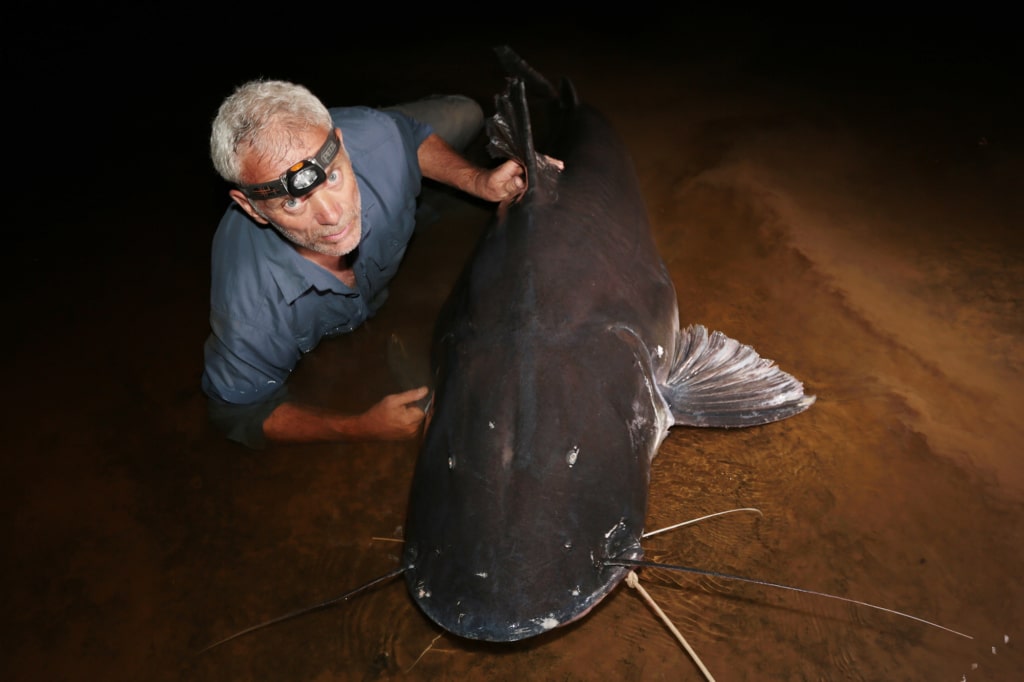
Piraiba catfish (Brachyplatystoma filamentosum) Essequibo river, Guyana © Icon Films
Q: What are some of the things you’ve learnt from the people who have fished these places for generations?
JW: From talking to fishermen in different parts of the world, I’ve been struck by how common it is now to hear things like, “You know, 100 years ago this river was full of fish…”. People often talk about the scale of change over a – relatively short – timescale of a few generations.
One thing that is very clear is that catching freshwater fish is dependent on place and timing. Being in the right place is one thing, but you also have to be there at the right time of year. If you’re there at the wrong time you might as well not bother. Of course, there’s always a bit of uncertainty about what state the river is going to be in, and a certain amount of variation. But what I’ve found, just about everywhere I’ve been, especially over the last 10 years or so – everywhere from the far East of Russia to South America, through Europe and Africa – is that people are saying the whole cycle has become far more unpredictable. What’s interesting is that these people are not scientists. These are people whose lives depend on the river, people who are watching the river very closely, people who have inherited knowledge of what happens on that river. They say that over the last 10 years, they just can’t predict it any more. So, of course, this affects the fish.
You can imagine fish migrations where the river is going up so the fish start to head upstream, only for the water to suddenly start coming back down again, without ever properly rising. I’ve seen a similar thing with freshwater turtles in Guyana. The river starts going down, exposing the sandbars so the turtles think it’s time to breed, dig a nest and lay their eggs, then they get back in the river and it starts coming up again, washing away the nests! It’s another false start to the dry season.
So this really is happening, and perhaps one way to engage people in climate change is to show how it affects certain animals. People seem to love turtles, so if turtles come under the remit of Shoal, then I think that could be an interesting leverage point.
Q: I think the aim for Shoal is ultimately to try to increase support for all freshwater species, so turtles would certainly come under its remit. So, do you think the key to drawing people in is to focus on the more ‘iconic’ species, and particularly the apex predators, as you often do in your shows?
JW: Well, I guess it could be seen as a fairly cheap trick, in a way, but what I’ve realised – and this is part of the DNA of River Monsters – is that everybody is fascinated by predators. If they tell you otherwise, they’re lying! For our ancestors, it was all about paying attention to those things in the environment that were dangerous, so it’s absolutely fundamental to who we are as living beings. For River Monsters, we start with a story – here’s this fierce animal that bites people – and we immediately have people’s attention. Then, from there, we can take the story wherever we want it to go.
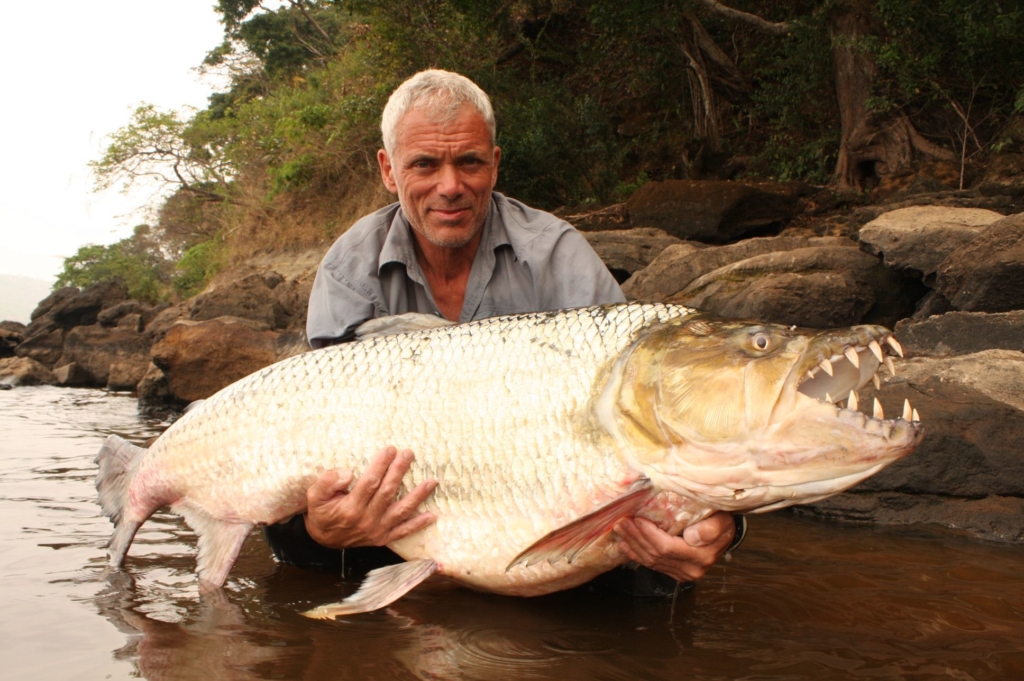
Goliath tigerfish (Hydrocynus goliath), Congo river © Icon Films
Q: Anglers are clearly an important audience for your programmes. What role do you think anglers can – and should – play in freshwater conservation?
JW: Anglers have an incredibly important role as the eyes and ears of what is out there. By teaming up with scientists and through citizen science initiatives, they can be a very useful resource in helping to understand what is happening to rivers and lakes. But on a more fundamental level, an angler’s pastime depends on fish, so it really should be a duty to have a concern for the wider world of fish.
It’s about having a respect for freshwater fish and to express that in as many ways as possible. I think some anglers don’t particularly care, but an awful lot do. I think there are enough anglers who care to make a huge difference.
Q: What attracted you to Shoal?
JW: I get lots of requests to attend events or promote particular things, and it’s often difficult because of time. But the reason I wanted to support Shoal is right there in your Mission Statement: you have identified a void. Here is this freshwater habitat, and a group of creatures which is very important to me – and which has given me something of a career – that in terms of wider public interest just doesn’t get the attention it deserves. While there are countless campaigns to try to help other wildlife and wild places, poor old freshwater fish seem to miss out!
One of the reasons River Monsters was very successful was because here was a subject that hadn’t really been covered before in wildlife documentaries. It’s something that people didn’t know very much about, which in some ways is an advantage, because if you can find a good way to do it, then it’s really something new for people.
I think what freshwater conservation needs now – and some people are starting to wake up to this – is for the level of support to be brought into line with what you’ve got for tigers, pandas, orangutans and all the other species and habitats that get most of the attention, and I think Shoal is one way to start to do this.
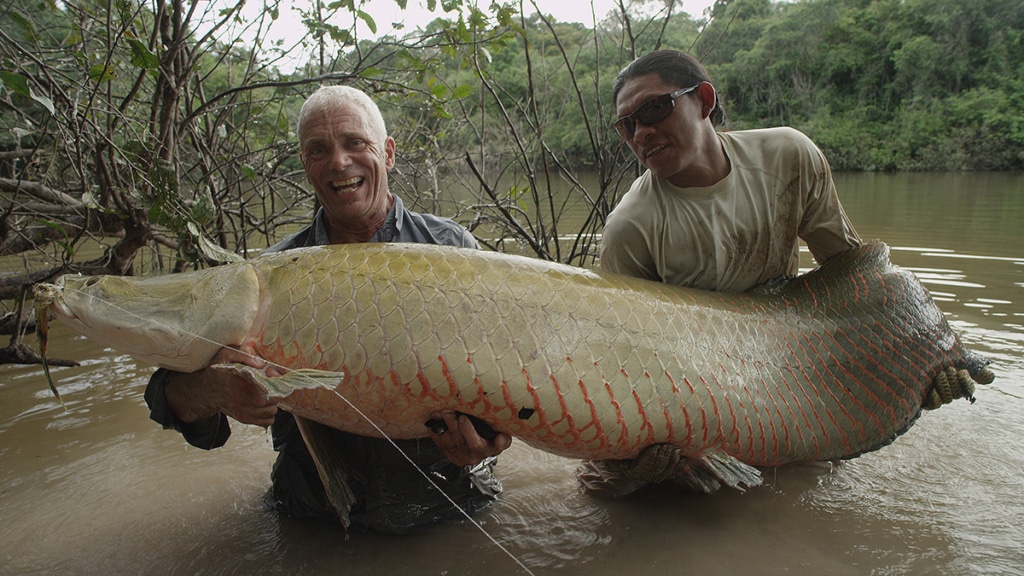
Arapaima (Arapaima gigas) © Icon Films
Q: What gives you hope and optimism for the future of freshwater fish and freshwater environments more generally?
JW: Well, in making the series Mighty Rivers, what we were looking for was not just ‘doom and gloom’ but also some of the good news stories. Of course, if there had been no good news stories, then that would have been depressing, but actually if you look, there are quite a lot of positive stories out there. There are things happening in different places – often quite small things, but with great potential.
One example would be the scientists I met in India who have developed a way of seeing pollution in the water by flying over the river using infrared photography. It’s also been inspiring to see how extractive reserves are being used in some parts of Brazil. These reserves are a kind of halfway house where it’s not a free for all, or the type of reserve where you kick everyone out. In these reserves, people can continue to harvest what they need from the environment and the idea is not to stop that, but instead to look at helping people to continue doing it in sustainable ways through local management – the local communities take responsibility for this. I saw how successful this approach could be with arapaima, this iconic fish from the Amazon. While it is true that arapaima is a particularly fast-growing species, so it was perhaps easier, as a model this is certainly something to aspire to.
Q: Last question: Say you turn up at a place you’ve never visited before, looking for a particular fish, and you could only ask either a scientist or a local where to find it, who would you ask and why?
JW: That’s an easy one – I’ll ask the local! Ok, they might not have the studies and paperwork to back it up, but for people who fish, it’s all about observing the water – their livelihood depends on it. There is a really strong incentive to understand the water. If you’re a scientist, you know, you can walk away and write a paper and even if nobody understands what you’re talking about, this doesn’t mean you’re out of a job. For people fishing the river, it’s their lives on the line. And the locals are really amateur scientists anyway. A lot of their knowledge – not just in terms of the history of a river or place, but also fish behaviour – is not written down. Maybe somebody needs to write it down while it’s still there. It would be a huge project but it would provide an incredibly valuable record. In a sense, the important thing, for me, is that there is no hard boundary between this local knowledge and the science. One type of knowledge shades into the other and good scientists understand that and are dependent on local knowledge.

